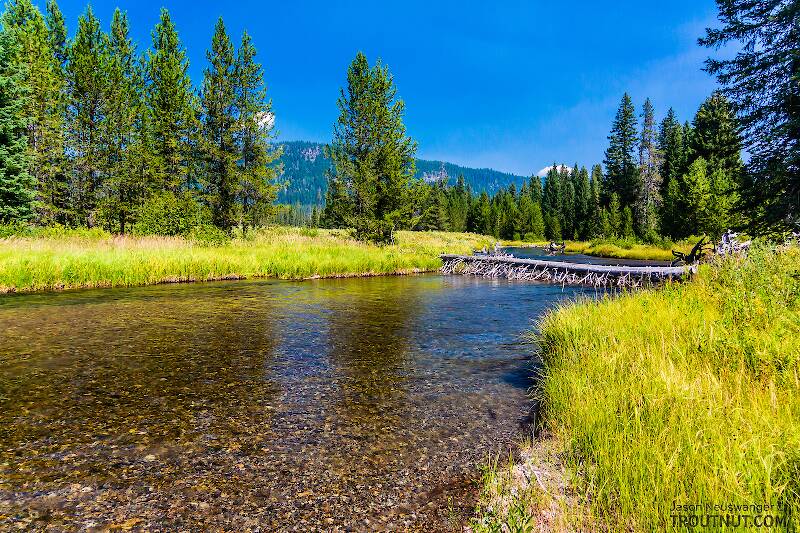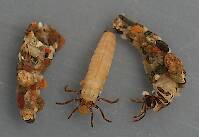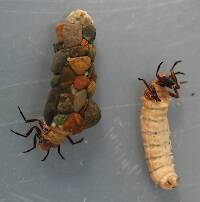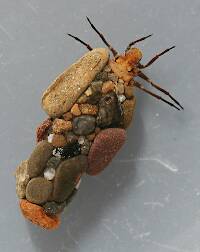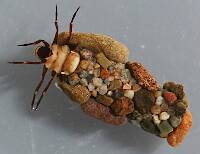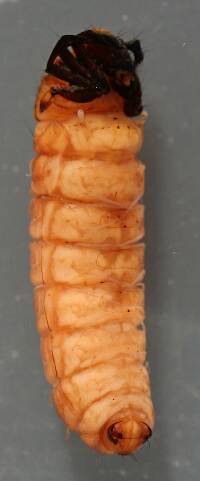
Salmonflies
Pteronarcys californica
The giant Salmonflies of the Western mountains are legendary for their proclivity to elicit consistent dry-fly action and ferocious strikes.
Featured on the forum

This one was surprisingly straightforward to identify. The lack of a sclerite at the base of the lateral hump narrows the field quite a bit, and the other options followed fairly obvious characteristics to Clostoeca, which only has one species, Clostoeca disjuncta.

Troutnut is a project started in 2003 by salmonid ecologist Jason "Troutnut" Neuswanger to help anglers and
fly tyers unabashedly embrace the entomological side of the sport. Learn more about Troutnut or
support the project for an enhanced experience here.
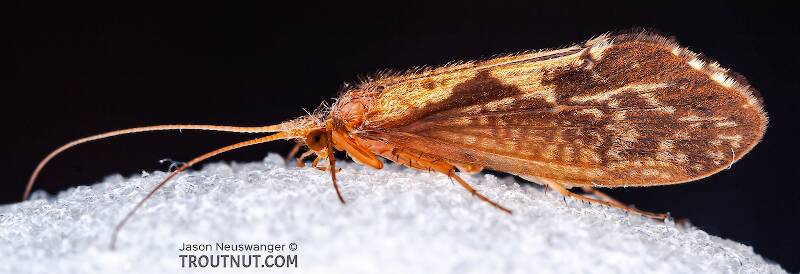
This large caddisfly looks really neat close-up.
Martinlf on Nov 18, 2006November 18th, 2006, 1:18 pm EST
I have the following entry in my journal for Clark's Creek, north of Harrisburg PA: "June 12, 2004. Arrived late to find Al already on the stream. He showed me a big yellow bodied, tan wing caddis that he says comes off this time every year."
Al lives near Clarks, and knows the stream very well. The bug was about a size 12 or 14. It looked very much like the one in the pictures Jason posted. It had an abdomen that I remember looked like a big ant's (full, smooth, and clearly segmented) with a very thin waist at the front of the abdomen like the front of an ant's gaster. How many big yellow bodied caddis like this are there? I'm just wondering if I can surmise that the bug Al showed me might be the same as the one here, or if there are so many caddis like this one that there is no way of even suggesting such.
Al lives near Clarks, and knows the stream very well. The bug was about a size 12 or 14. It looked very much like the one in the pictures Jason posted. It had an abdomen that I remember looked like a big ant's (full, smooth, and clearly segmented) with a very thin waist at the front of the abdomen like the front of an ant's gaster. How many big yellow bodied caddis like this are there? I'm just wondering if I can surmise that the bug Al showed me might be the same as the one here, or if there are so many caddis like this one that there is no way of even suggesting such.
"He spread them a yard and a half. 'And every one that got away is this big.'"
--Fred Chappell
--Fred Chappell
Troutnut on Nov 18, 2006November 18th, 2006, 4:17 pm EST
Quite a few caddisflies look somewhat like this. Given the difference in time of year (this specimen was caught in October) I would guess they're different species. There are some caddisflies that are around in both months, but they're certainly the exception rather than the rule.
Jason Neuswanger, Ph.D.
Troutnut and salmonid ecologist
Troutnut and salmonid ecologist
GONZO on Nov 19, 2006November 19th, 2006, 6:46 am EST
Louis-
With a few notable exceptions, size and color only present general possibilities with regard to caddisfly identification. When lacking definitive keys and the tools (magnification) to use them, amateur fly-fishing entomologists (like me) are left to deduce clues from distribution, season, water-type, behavior, and the (sometimes inaccurate) jottings of other amateurs. We proceed based on educated guesses and leave most of the truly nit-picky stuff to the pros. (We simply make too many mistakes otherwise.) That said, when anglers become well-aquainted with a species they often recognize it more readily than the (non-angling) professional entomologists do.
As far as I know, all of the trout-stream Neophylax are fall (October/November) emergers. It is a fairly safe bet that the species-in-question on Clark's is just another of the many common Hydropsyche/Ceratopsyche spp. One interesting local aspect is that Dauphin County waters appear to favor Hydropsyche spp. and adjacent Cumberland County waters appear to favor Ceratopsyche spp. This would seem to suggest something about freestone vs. limestone favorability, but I suspect that it is just a quirk of the collecting record.
With a few notable exceptions, size and color only present general possibilities with regard to caddisfly identification. When lacking definitive keys and the tools (magnification) to use them, amateur fly-fishing entomologists (like me) are left to deduce clues from distribution, season, water-type, behavior, and the (sometimes inaccurate) jottings of other amateurs. We proceed based on educated guesses and leave most of the truly nit-picky stuff to the pros. (We simply make too many mistakes otherwise.) That said, when anglers become well-aquainted with a species they often recognize it more readily than the (non-angling) professional entomologists do.
As far as I know, all of the trout-stream Neophylax are fall (October/November) emergers. It is a fairly safe bet that the species-in-question on Clark's is just another of the many common Hydropsyche/Ceratopsyche spp. One interesting local aspect is that Dauphin County waters appear to favor Hydropsyche spp. and adjacent Cumberland County waters appear to favor Ceratopsyche spp. This would seem to suggest something about freestone vs. limestone favorability, but I suspect that it is just a quirk of the collecting record.
JAD on Nov 19, 2006November 19th, 2006, 9:09 am EST
Ok guys now you got my mind going, see if you can fallow this .
On oct 20 we had this discussion.
!.The Eastern "October Caddis" is more often referred to (in angling and scientific literature) as the Great Brown Autumn Sedge or the Giant Red Sedge. It has cinnamon or pumpkin colored wings with a darker rear margin and two characteristic brown patches on the rear half of the wing. The genus is Pycnopsyche, and the more common PA species are P. guttifer, lepida, and scabripennis. In older books they are listed under the former genus name Stenophylax.
The cream-colored larvae build very large cases comprised of lengthwise sticks with small stones and stick fragments between. I haven't found imitating the larvae to be worthwhile, but imitations of the pupae and adults can be quite useful in the fall. ---GONZO---Posted: Fri Oct 20, 2006 3:15 pm Post subject: ID on Eastern "October Caddis" this was on --Spruce Creek Fly Company Forum Index
This caddis emerges by crawling to shallow water.
Then today it is posted --Autum Mottled Sedges
As far as I know, all of the trout-stream Neophylax are fall (October/November) emergers. --Gonzo
Gonzo or any one else, how does Neophylax (Autum Mottled Sedges) emerge and is their top water action
The reason I'm asking in October on the little J their was a caddis hatching and im not sure which one was hatching. I tried like a son of a gun to catch one but no luck. Their both about size 14 and look cream or tan from a distance. At that time I caught some fish on a cream comparadun,I was wondering if I had used a caddis emerger if I would have caught as many or more fish.
On oct 20 we had this discussion.
!.The Eastern "October Caddis" is more often referred to (in angling and scientific literature) as the Great Brown Autumn Sedge or the Giant Red Sedge. It has cinnamon or pumpkin colored wings with a darker rear margin and two characteristic brown patches on the rear half of the wing. The genus is Pycnopsyche, and the more common PA species are P. guttifer, lepida, and scabripennis. In older books they are listed under the former genus name Stenophylax.
The cream-colored larvae build very large cases comprised of lengthwise sticks with small stones and stick fragments between. I haven't found imitating the larvae to be worthwhile, but imitations of the pupae and adults can be quite useful in the fall. ---GONZO---Posted: Fri Oct 20, 2006 3:15 pm Post subject: ID on Eastern "October Caddis" this was on --Spruce Creek Fly Company Forum Index
This caddis emerges by crawling to shallow water.
Then today it is posted --Autum Mottled Sedges
As far as I know, all of the trout-stream Neophylax are fall (October/November) emergers. --Gonzo
Gonzo or any one else, how does Neophylax (Autum Mottled Sedges) emerge and is their top water action
The reason I'm asking in October on the little J their was a caddis hatching and im not sure which one was hatching. I tried like a son of a gun to catch one but no luck. Their both about size 14 and look cream or tan from a distance. At that time I caught some fish on a cream comparadun,I was wondering if I had used a caddis emerger if I would have caught as many or more fish.
They fasten red (crimson red) wool around a hook, and fix onto the wool two feathers which grow under a cock’s wattles, and which in colour are like wax.
Radcliffe's Fishing from the Earliest Times,
GONZO on Nov 19, 2006November 19th, 2006, 9:25 am EST
If the caddisfly you saw was truly about a size 14, then Pycnopsyche is unlikely. Most Pycnopsyche spp. are larger, in the #8-10 range , or about 20mm (wing length). Both genera (Pycnopsyche and Neophylax) are found in your area. The Little J doesn't strike me as typical habitat for Neophylax; but we have them on the Breeches as well, so it is certainly possible. As far as I know, Neophylax is a surface emerger in riffled water. My best guess is that the pupa/emerger might have produced better. Cream is an unlikely color for the Neophylax I'm familiar with, but that could just be the old problem of a caddisfly appearing lighter on the wing than in hand.
I'm quite confident that the caddisfly that was discussed on the Spruce Creek site was Pycnopsyche. The term "October Caddis," however, only has a specific meaning in a Western context (when it refers to Dicosmoecus spp.). In the East, one can only assume that it signifies a caddisfly that emerges in October, which would apply to Neophylax or Pycnopsyche.
I'm quite confident that the caddisfly that was discussed on the Spruce Creek site was Pycnopsyche. The term "October Caddis," however, only has a specific meaning in a Western context (when it refers to Dicosmoecus spp.). In the East, one can only assume that it signifies a caddisfly that emerges in October, which would apply to Neophylax or Pycnopsyche.
DarkDun
Posts: 16
Posts: 16
DarkDun on Oct 22, 2007October 22nd, 2007, 4:56 pm EDT
JAD do you have information on the leg colors of the fly and any other color characteristics to this Oct Caddis pupae. I would like to tie some emergers and give them a test on our finicky trout. I surmise that the pupae would be tied on a #10 hook or a #12 2x long to be right for our eastern October Caddis (Neophylax)that both of us seem to encounter in late fall on our respective waters of PA and NC.
The way I fish this fly is in the heaviest riffles I can find and dead drift just below the surface thru the riffle until the line tugs or hesitates. The fish hit it hard and mostly hook themselves in most cases. This fly emerges in the margins of riffs as far as I can tell, sporadically and often is seen only in the air rather than on the surface. That is why they are so hard to catch, being airborne. They seem to be fast fliers unlike most caddis, which kind of dribble along in flight.
The way I fish this fly is in the heaviest riffles I can find and dead drift just below the surface thru the riffle until the line tugs or hesitates. The fish hit it hard and mostly hook themselves in most cases. This fly emerges in the margins of riffs as far as I can tell, sporadically and often is seen only in the air rather than on the surface. That is why they are so hard to catch, being airborne. They seem to be fast fliers unlike most caddis, which kind of dribble along in flight.
JAD on Oct 23, 2007October 23rd, 2007, 2:38 am EDT
Hello all
(JAD do you have information on the leg colors of the fly and any other color characteristics to this Oct Caddis pupae.) Sorry Dark Dun I tried to catch any part of this caddis, no luck. I think they hatch from the rocks along the shore. The fish were not working the surface for emergers . (That is why they are so hard to catch, being airborne. They seem to be fast fliers unlike most caddis, which kind of dribble along in flight.)
They do zip along pretty fast I would need long legged Louis to catch them :) I did really well on of all things a Tan size 12 Coparadun right before dark , I caught some really large fish so I think the fishing got better later at night -Not for me.
I read this on another board----
bigjohn58----------------http://www.flyfishersparadise.com/
Member
Posts: 194
Registered: Jun 2001
posted 10-22-2007 11:28 AM Reply w/Quote If you are thinking of Fishing Creek make sure you have a few tan caddis flies along. They were everywhere yesterday and pretty thick.
From the above reply I think Big John ran into the same hatch on 10/22/07
Sorry I couldn't be more help.
john
They fasten red (crimson red) wool around a hook, and fix onto the wool two feathers which grow under a cock’s wattles, and which in colour are like wax.
Radcliffe's Fishing from the Earliest Times,
IEatimago on Oct 23, 2007October 23rd, 2007, 3:48 am EDT
true tan caddis were very thick yesturday , i was near fishing creek on a smaller stream.
also i have noticed these october caddis, i call em orange sedges around here at night.
looks very similar to the one posted exept the wings seem more uniform in color.
also i have noticed these october caddis, i call em orange sedges around here at night.
looks very similar to the one posted exept the wings seem more uniform in color.
Flyguy212 on Oct 1, 2009October 1st, 2009, 1:05 pm EDT
look like u cold tie a elk hair caddies fly to imitate it
Quick Reply
Related Discussions
Topic
Replies
Last Reply
14
Sep 26, 2013
by Crepuscular
by Crepuscular
2
Nov 4, 2012
by Aszat
by Aszat
Five days of warmwater flyfishing in southeastern Michigan - from Jonathon
In Fishing Reports by Jmd123
In Fishing Reports by Jmd123
0
Jul 22, 2009
by Jmd123
by Jmd123

